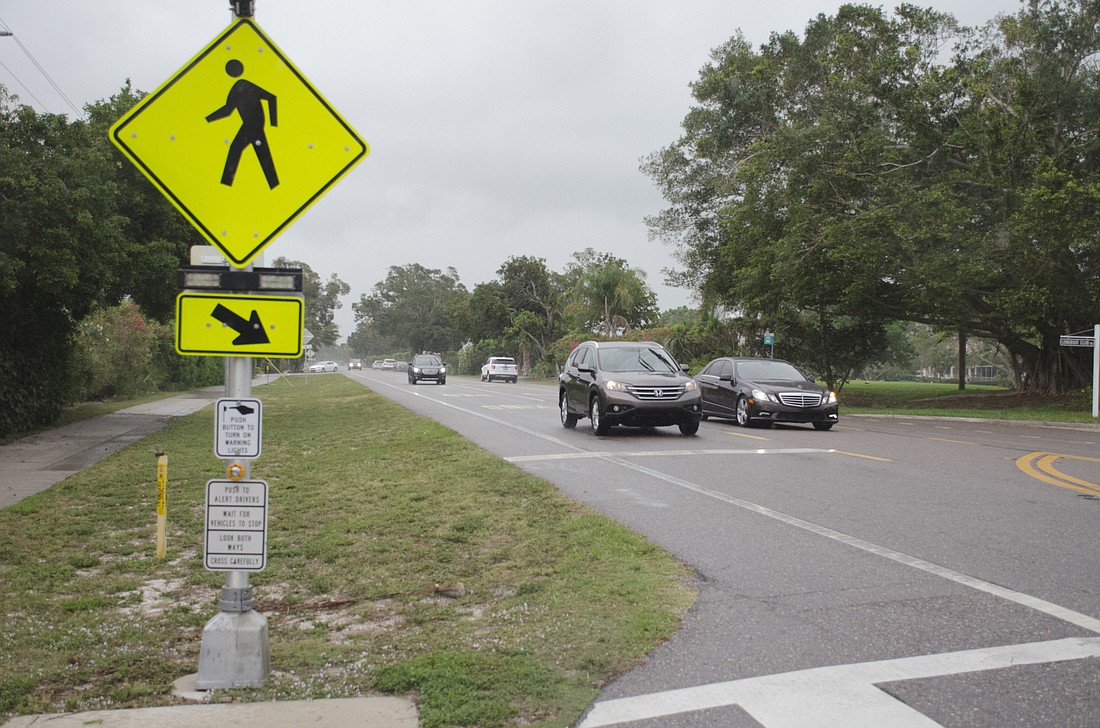- April 27, 2024
-
-
Loading

Loading

The death of a man crossing Gulf of Mexico Drive last week once again brought into focus an issue familiar to Longboat Key residents: pedestrian safety on Gulf of Mexico Drive.
Warren Roberts, 85, was killed along the stretch of road near Whitney Beach, crossing from his home to the beach before dawn, something he did nearly every day.
The incident took place about 600 yards from the nearest crosswalk, which features flashing lights, signs and roadway markings.
“People tend to cross where they are,” said Pam Fischer, a pedestrian safety consultant with the Governors Highway Safety Association. “If the crosswalk is any distance, they may not be amenable to using it.”
Mayor George Spoll, who was at the scene of the crash, said more could be done to improve safety for pedestrians on Gulf of Mexico Drive, including possibly adding a crosswalk at the location of the accident.
There are five on-demand crosswalks on Longboat Key that allow pedestrians to find their way across a thoroughfare with speed limits as high as 45 mph. That corridor also hosts 12 beach access points, according to the town website, many of which are more than 100 yards from the nearest crosswalk.
But that's not to say that crosswalks can be placed anywhere to provide safe crossing. A crosswalk is the infrastructure established to tell pedestrians where it's safe to cross: highway engineers avoid placing them in inherently hazardous sites, like on blind curves or high speed zones.
The FDOT uses a national standard to establish where crosswalks go and what kind of signage will alert drivers to their presence. Those requirements suggest any section of roadway with 20 pedestrian crossings per hour should have a crosswalk, said Zac Burch, a spokesman for the department.
"There's a balancing act; there are some places that we don't want to encourage people to cross at," Burch said. "We cant stop people from doing it, but we’d rather encourage people to cross at a different location."
And older people, because of their frailty, are much more susceptible to fatal injuries when hit by vehicles, according to the National Highway Traffic Safety Administration. Almost one in five of the pedestrians killed by motor vehicles in 2015 were 65 or older, according to the Centers for Disease Control.
That demographic constitutes almost three-quarters of Longboat Key’s population, according to the United States Census.
Pedestrian mobility and safety are part of the Florida Department of Transportation’s Barrier Island Traffic Study, which has been working with the town and other municipalities for more than a year. Burch said FDOT has been collecting data on how the town’s crosswalks are used and where new ones might be considered.
“What happened earlier this week is tragic, we are not going to rest on our laurels and accept that this is a one off [circumstance],” Burch said last week. “We’re certainly going to work with the town on the crossing and continue to monitor the area to do all that we can to make the improvements that are necessary.”
But crosswalks were not always fully supported on Longboat Key. Two months after they were first installed on GMD in 2016, a pedestrian was struck in a crosswalk near Country Club Shores. The town immediately demanded upgrades or the removal of the crosswalks. FDOT made the upgrades but did not agree to add small medians near the crosswalk sites, designed to further heighten driver awareness.
Other options for ensuring pedestrian safety may also be considered, Burch said, including more signage to alert motorists to upcoming pedestrian crossings or decreasing the speed limit along the corridor.
Speed limits are “a real issue” when it comes to pedestrian safety, Fischer said. A pedestrian hit by a vehicle traveling 40 miles per hour is 40% more likely to die from a crash than if the motorist were driving 30 miles per hour, according to the National Highway Traffic Safety Administration.
Police Chief Pete Cumming said the average speed of drivers on Gulf of Mexico Drive, on any given day, is often slower than the speed limit of 45 miles per hour. And when he saw a motorist drive through an on-demand crosswalk with its lights flashing recently, Cumming said he stopped the driver.
"If those lights are flashing and people are crossing, we're stopping them," Cumming said of motorists.
Education about pedestrian and motorist safety is also an important component of making roadways safe for everyone who uses them, Burch said. Part of making a roadway safer is ensuring that all who use it know how to do so safely.
That includes, for motorists, avoiding distracted driving, abiding by speed limits and abstaining from alcohol when getting into the driver’s seat. For pedestrians, that could mean using crosswalks properly, staying alert and wearing reflective or luminous clothing.
Fisher recommended pedestrians use a free mobile application called PedSafe, which flashes random amber pattern on a phone screen to alert motorists. Bright or reflective clothing may also be helpful to alert drivers to a pedestrian’s location.
“I can’t overstate how important it is for pedestrians to be as visible as possible,” Fischer said.